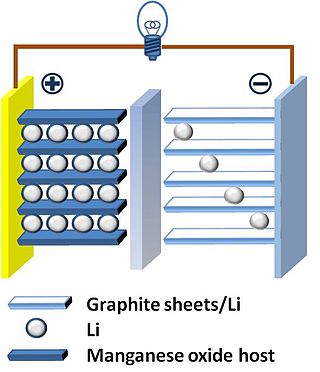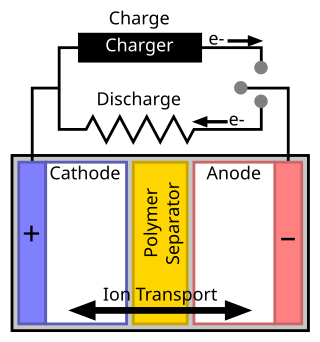Related Research Articles

An electrode is an electrical conductor used to make contact with a nonmetallic part of a circuit. Electrodes are essential parts of batteries that can consist of a variety of materials depending on the type of battery.

A lithium-ion or Li-ion battery is a type of rechargeable battery which uses the reversible reduction of lithium ions to store energy. The negative electrode of a conventional lithium-ion cell is typically graphite, a form of carbon. This negative electrode is sometimes called the anode as it acts as an anode during discharge. The positive electrode is typically a metal oxide; the positive electrode is sometimes called the cathode as it acts as a cathode during discharge. Positive and negative electrodes remain positive and negative in normal use whether charging or discharging and are therefore clearer terms to use than anode and cathode which are reversed during charging.
A polymer-based battery uses organic materials instead of bulk metals to form a battery. Currently accepted metal-based batteries pose many challenges due to limited resources, negative environmental impact, and the approaching limit of progress. Redox active polymers are attractive options for electrodes in batteries due to their synthetic availability, high-capacity, flexibility, light weight, low cost, and low toxicity. Recent studies have explored how to increase efficiency and reduce challenges to push polymeric active materials further towards practicality in batteries. Many types of polymers are being explored, including conductive, non-conductive, and radical polymers. Batteries with a combination of electrodes are easier to test and compare to current metal-based batteries, however batteries with both a polymer cathode and anode are also a current research focus. Polymer-based batteries, including metal/polymer electrode combinations, should be distinguished from metal-polymer batteries, such as a lithium polymer battery, which most often involve a polymeric electrolyte, as opposed to polymeric active materials.

Nanobatteries are fabricated batteries employing technology at the nanoscale, particles that measure less than 100 nanometers or 10−7 meters. These batteries may be nano in size or may use nanotechnology in a macro scale battery. Nanoscale batteries can be combined to function as a macrobattery such as within a nanopore battery.
A nanowire battery uses nanowires to increase the surface area of one or both of its electrodes, which improves the capacity of the battery. Some designs, variations of the lithium-ion battery have been announced, although none are commercially available. All of the concepts replace the traditional graphite anode and could improve battery performance. Each type of nanowire battery has specific advantages and disadvantages, but a challenge common to all of them is their fragility.

A lithium-ion capacitor is a hybrid type of capacitor classified as a type of supercapacitor. It is called a hybrid because the anode is the same as those used in lithium-ion batteries and the cathode is the same as those used in supercapacitors. Activated carbon is typically used as the cathode. The anode of the LIC consists of carbon material which is often pre-doped with lithium ions. This pre-doping process lowers the potential of the anode and allows a relatively high output voltage compared to other supercapacitors.

The lithium–sulfur battery is a type of rechargeable battery. It is notable for its high specific energy. The low atomic weight of lithium and moderate atomic weight of sulfur means that Li–S batteries are relatively light. They were used on the longest and highest-altitude unmanned solar-powered aeroplane flight by Zephyr 6 in August 2008.

The thin film lithium-ion battery is a form of solid-state battery. Its development is motivated by the prospect of combining the advantages of solid-state batteries with the advantages of thin-film manufacturing processes.
A solid-state battery deploys solid-state technology using solid electrodes and a solid electrolyte, instead of the liquid or polymer gel electrolytes found in lithium-ion or lithium polymer batteries.
Nanoball batteries are an experimental type of battery with either the cathode or anode made of nanosized balls that can be composed of various materials such as carbon and lithium iron phosphate. Batteries which use nanotechnology are more capable than regular batteries because of the vastly improved surface area which allows for greater electrical performance, such as fast charging and discharging.
The lithium–air battery (Li–air) is a metal–air electrochemical cell or battery chemistry that uses oxidation of lithium at the anode and reduction of oxygen at the cathode to induce a current flow.
A potassium-ion battery or K-ion battery is a type of battery and analogue to lithium-ion batteries, using potassium ions for charge transfer instead of lithium ions. It was invented by the Iranian/American chemist Ali Eftekhari in 2004.

A separator is a permeable membrane placed between a battery's anode and cathode. The main function of a separator is to keep the two electrodes apart to prevent electrical short circuits while also allowing the transport of ionic charge carriers that are needed to close the circuit during the passage of current in an electrochemical cell.

A supercapacitor (SC), also called an ultracapacitor, is a high-capacity capacitor, with a capacitance value much higher than other capacitors but with lower voltage limits. It bridges the gap between electrolytic capacitors and rechargeable batteries. It typically stores 10 to 100 times more energy per unit volume or mass than electrolytic capacitors, can accept and deliver charge much faster than batteries, and tolerates many more charge and discharge cycles than rechargeable batteries.
Research in lithium-ion batteries has produced many proposed refinements of lithium-ion batteries. Areas of research interest have focused on improving energy density, safety, rate capability, cycle durability, flexibility, and cost.
Lithium–silicon battery is a name used for a subclass of lithium-ion battery technology that employs a silicon-based anode and lithium ions as the charge carriers. Silicon based materials generally have a much larger specific capacity, for example 3600 mAh/g for pristine silicon, relative to graphite, which is limited to a maximum theoretical capacity of 372 mAh/g for the fully lithiated state LiC6. Silicon's large volume change (approximately 400% based on crystallographic densities) when lithium is inserted is one of the main obstacles along with high reactivity in the charged state to commercializing this type of anode. Commercial battery anodes may have small amounts of silicon, boosting their performance slightly. The amounts are closely held trade secrets, limited as of 2018 to at most 10% of the anode. Lithium-silicon batteries also include cell configurations where Si is in compounds that may at low voltage store lithium by a displacement reaction, including silicon oxycarbide, silicon monoxide or silicon nitride.
Magnesium batteries are batteries that utilize magnesium cations as the active charge transporting agents in solution and often as the elemental anode of an electrochemical cell. Both non-rechargeable primary cell and rechargeable secondary cell chemistries have been investigated. Magnesium primary cell batteries have been commercialised and have found use as reserve and general use batteries.
Structural batteries are multifunctional materials or structures, capable of acting as an electrochemical energy storage system while possessing mechanical integrity.
A solid state silicon battery or silicon anode all solid state battery is a type of rechargeable lithium ion battery consisting of a solid electrolyte, solid cathode, and silicon-based solid anode.

This is a history of the lithium-ion battery.
References
- 1 2 Aricò, A. S.; Bruce, P.; Scrosati, B.; Tarascon, J. M.; Van Schalkwijk, W. (2005). "Nanostructured materials for advanced energy conversion and storage devices". Nature Materials. 4 (5): 366–377. Bibcode:2005NatMa...4..366A. doi:10.1038/nmat1368. PMID 15867920. S2CID 35269951.
- 1 2 Graetz, J.; Ahn, C. C.; Yazami, R.; Fultz, B. (2003). "Highly Reversible Lithium Storage in Nanostructured Silicon" (PDF). Electrochemical and Solid-State Letters. 6 (9): A194. doi:10.1149/1.1596917.
- ↑ Larcher, D.; Beattie, S.; Morcrette, M.; Edström, K.; Jumas, J. C.; Tarascon, J. M. (2007). "Recent findings and prospects in the field of pure metals as negative electrodes for Li-ion batteries". Journal of Materials Chemistry. 17 (36): 3759. doi:10.1039/B705421C.
- ↑ Talyosef, Y.; Markovsky, B.; Lavi, R.; Salitra, G.; Aurbach, D.; Kovacheva, D.; Gorova, M.; Zhecheva, E.; Stoyanova, R. (2007). "Comparing the Behavior of Nano- and Microsized Particles of LiMn1.5Ni0.5O4 Spinel as Cathode Materials for Li-Ion Batteries". Journal of the Electrochemical Society. 154 (7): A682. Bibcode:2007JElS..154A.682T. doi:10.1149/1.2736657.
- 1 2 3 4 Long, Jeffrey W.; Dunn, Bruce; Rolison, Debra R.; White, Henry S. (Oct 2004). "Architectures, Three-Dimensional Battery". Chem. Rev. 104 (10): 4463–4492. doi:10.1021/cr020740l. PMID 15669159.
- ↑ Dunn, Bruce; Long, Jeffrey W.; Rolison, Debra R. "Rethinking Multifunction in Three Dimensions for Miniaturizing Electrical Energy Storage" (PDF). Electrochemical Society Interface. 2008: 49–53.
- ↑ Nathan, M.; Golodnitsky, D.; Yufit, V.; Strauss, E.; Ripenbein, T.; Shechtman, I.; Menkin, S.; Peled, E. (2005). "Three-dimensional thin-film Li-ion microbatteries for autonomous MEMS". Journal of Microelectromechanical Systems. 14 (5): 879–885. doi:10.1109/JMEMS.2005.851860. S2CID 17973543.
- ↑ Pikul, J. H.; Gang Zhang, H.; Cho, J.; Braun, P. V.; King, W. P. (2013). "High-power lithium ion microbatteries from interdigitated three-dimensional bicontinuous nanoporous electrodes". Nature Communications. 4: 1732. Bibcode:2013NatCo...4.1732P. doi:10.1038/ncomms2747. PMID 23591899. S2CID 14775192.
- ↑ Sun, K.; Wei, T. S.; Ahn, B. Y.; Seo, J. Y.; Dillon, S. J.; Lewis, J. A. (2013). "3D Printing of Interdigitated Li-Ion Microbattery Architectures". Advanced Materials. 25 (33): 4539–4543. Bibcode:2013AdM....25.4539S. doi:10.1002/adma.201301036. PMID 23776158. S2CID 41428069.
- ↑ "3-D printing could lead to tiny medical implants, electronics, robots, more | Engineering at Illinois". Engineering.illinois.edu. 2013-06-19. Archived from the original on 2013-07-09. Retrieved 2013-06-23.
- ↑ Ergang, N. S.; Lytle, J. C.; Lee, K. T.; Oh, S. M.; Smyrl, W. H.; Stein, A. (2006). "Photonic Crystal Structures as a Basis for a Three-Dimensionally Interpenetrating Electrochemical-Cell System". Advanced Materials. 18 (13): 1750–1753. Bibcode:2006AdM....18.1750E. doi:10.1002/adma.200600295. S2CID 137275587.
- ↑ Landi, B. J.; Ganter, M. J.; Schauerman, C. M.; Cress, C. D.; Raffaelle, R. P. (2008). "Lithium Ion Capacity of Single Wall Carbon Nanotube Paper Electrodes". Journal of Physical Chemistry C. 112 (19): 7509–7515. doi:10.1021/jp710921k.
- ↑ Kiebele, A.; Gruner, G. (2007). "Carbon nanotube based battery architecture". Applied Physics Letters. 91 (14): 144104. Bibcode:2007ApPhL..91n4104K. doi:10.1063/1.2795328.
- ↑ Pushparaj, Victor L.; Shaijumon, Manikoth M.; Kumar, Ashavani; Murugesan, Saravanababu; Ci, Lijie; Vajtai, Robert; Linhardt, Robert J.; Nalamasu, Omkaram; Ajayan, Pulickel M. (2007). "Flexible energy storage devices based on nanocomposite paper". PNAS. 104 (34): 13574–13577. Bibcode:2007PNAS..10413574P. doi: 10.1073/pnas.0706508104 . PMC 1959422 . PMID 17699622.
- ↑ Chan, C. K.; Peng, H.; Liu, G.; McIlwrath, K.; Zhang, X. F.; Huggins, R. A.; Cui, Y. (2007). "High-performance lithium battery anodes using silicon nanowires". Nature Nanotechnology. 3 (1): 31–35. Bibcode:2008NatNa...3...31C. doi:10.1038/nnano.2007.411. PMID 18654447.
- ↑ Shlyakhtin, Oleg A. "Glossary - ambigel". Glossary of nanotechnology terms. Retrieved April 9, 2015.
- 1 2 Rolison, D. R.; Long, J. W.; Lytle, J. C.; Fischer, A. E.; Rhodes, C. P.; McEvoy, T. M.; Bourg, M. E.; Lubers, A. M. (2009). "Multifunctional 3D nanoarchitectures for energy storage and conversion". Chemical Society Reviews . Royal Society of Chemistry. 38 (1): 226–252. doi:10.1039/B801151F. PMID 19088976.
- 1 2 3 4 Long, J. W.; Rolison, D. R. (2007). "Architectural Design, Interior Decoration, and Three-Dimensional Plumbing en Route to Multifunctional Nanoarchitectures". Accounts of Chemical Research. 40 (9): 854–862. doi:10.1021/ar6000445. PMID 17530736.
- ↑ Hayward, Ed (2015-02-25). "Boosting carbon's stability for better lithium-air batteries". R&D.